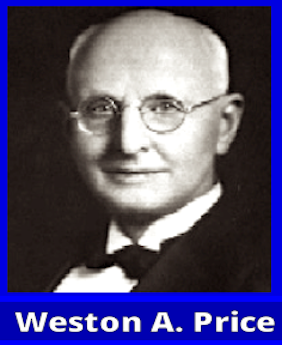Home / Weston A. Price, DDS, MS +
“Field studies gave important data
on waters and soils from
many districts, including one in Northern Africa where
the teeth of humans, and also
those of camels,
sheep, cows, goats, donkeys, and
horses, are seriously affected.”

Dr. Weston A. Price, DDS, MS –
(1893-1948)

Dr. Weston Andrew Price, [Official site] a graduate (1893) of the University of Michigan, is well known for his research on nutrition as it affects dental caries. Like related work of other researchers, Price´s publications are often cited as they incriminate “westernized diets containing high sugar and low fiber” as the main cause of dental caries. It could logically be assumed that a man with this background would not have much interest in fluoridation. Yet, like in the case of the Michigan Group, the matter is not that simple. Many are unaware that Price was, of course, involved in fluoride research.
..
In a discussion of Theodore Beust´s paper “The capillaries of the enamel and their relation to mottled teeth”, published in 1926, Price said: “As I had the pleasure of supporting in part the cooperation of the research commission with Dr. McKay´s original work, I have always been in close touch with the problem. About ten years ago, I started some chemical studies, particularly of the water. During part of Dr. McKay´s activity, in the determinations made on water sent from districts in accordance with his direction, we found a wide variance in chemical content, and the probabilities were then, in the light of our knowledge, that it was the absence of something, rather than the presence of something, in the water. That was as far as we could go”
.
1) A letter dated Feb. 1, 1927, from G. W. McCoy, director of the USPHS Hygienic Laboratory, to David C. White of the National Research Council, reveals: “I note that the Division of Medical Sciences of the National Research Council appointed a committee on Brown Staining of the Teeth in May 1926, with Weston A. Price Chairman”
.
2) From White´s reply it will appear, however, that this committee was not taken quite serious, for its existence was soon forgotten: “Following your suggestion I will resume the discussion with Dr. Hektoen, who, I think, forgot for the moment about having a committee on brown staining of the teeth”
.
3) While McKay thus continued his classical studies on mottled teeth with almost no support from that institution, in another corner of the world (Morocco, Algeria, and Tunisia) the same dystrophy known under the name of “Le Darmous” was under investigation for probably as long a time as “mottled enamel” was studied in the United States. The findings of a research group around the veterinarian Dr. Henri Velu, pointing to the same etiological agent, fluorine, also became available in 1931 but few are aware of the part played by Weston Price in these North African studies. Successive steps in the epidemiology were worked out by the group with meticulous detail in respect to the areas of rock phosphate and the influence of population movements recorded. Animal experiments included numerous studies with rats and one with young sheep continued over two years. A large amount of presumptive evidence pointed to fluorine as the causative factor, yet the final question confronting the workers was: do the waters producing this condition actually contain fluoride? So they sent two samples to Weston Price who analyzed them in his laboratory in Cleveland, Ohio, and found 2.3 and 3.1 ppm fluoride
.
4) In his paper “Evidence of a need for fluorine in optimum amounts for plant and animal growth, and bone and tooth development, with thresholds for injury”
5) At the 10th General Meeting of the International Association for Dental Research, March 1932, Price refers to that work in the following way: “Field studies gave important data on waters and soils from many districts, including one in Northern Africa where the teeth of humans, and also those of camels, sheep, cows, goats, donkeys, and horses, are seriously affected. The waters from this district contain from 23 to 31 parts of F per ten million, determined by the Jacob and Reynolds method. The rocks from this district contained 5.38 percent of F, or 53,800 parts per million. This is the highest figure in our series, and higher than any found in the literature.”
Dr. Price died Jan. 23, 1948, at his home in Santa Monica, CA, from cardiac failure.
.
6) References:
1) Price W.A.: J. Am. Dent. Assn. 13 (1926) 1011;
2) Letter G. W. McCoy to David C. White, Feb. 1, 1927, in the H. T. Dean papers, Natl. Lib. of Medicine;
3) Letter David C. White to G. W. McCoy, Feb. 4, 1927, in the H. T. Dean papers;
4) Remarks by H. Trendley Dean at the dinner given by the Cleveland Dental Society, Oct. 7, 1943, on the occasion of the celebration of Dr. Weston A. Price´s fifty years in the practice of dentistry; in the H. T. Dean papers, National Library of Medicine;
5) Price W.: “Evidence of a need for fluorine in optimum amounts for plant and animal growth, and bone and tooth development, with thresholds for injury”, J. dent. Res. 12 (1932) 545;
6) “Weston A. Price dies in California on January 23”, J. Am. Dent. Assoc. 36 (April/May 1948) 416







